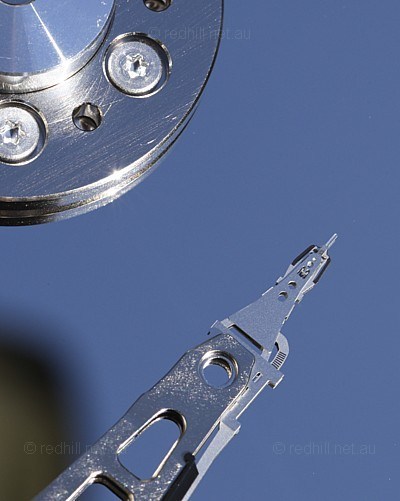
Hitachi Deskstar 180GXP (80GB, 2003).
Update your bookmark
This is the old site. You probably want the new site.
The new site has all the same information but adds more drives, updated text, and much better pictures of many models.
- Alps DRR-40
- Western Digital Caviar AC140
- Quantum LPS-52AT
- Seagate ST3144A new
- Kalock Octagon KL3100
- Samsung SHD-3121A
- Quantum LPS-127AT
- Maxtor 7213A
- Western Digital AC2200
- Seagate ST-3243A
- Conner CFS210A
- IBM H3256
- Seagate ST3290A new
- Western Digital AC2340
- Maxtor 7345A
- Seagate Medalist 425xe
- Western Digital AC2420
- Conner CFS 420A
This old version of the Red Hill guide hasn't been updated for about ten years. The new version can be found here.
Again, these are all long out of production. Some of the more recent ones were still fairly common as trade-ins up until the late 1990s, and were perfectly capable of doing useful work in the right circumstances for a long time after that.
1992 Drive of the Year
Western Digital Caviar
All things considered, the original Caviars were quite possibly the best hard drives Western Digital ever made: fast, much easier to set up than any other drive then made, a very neat , clean design, and almost bullet-proof by the standards of the day.
The AC140 was perhaps the very best of all the 40MB IDE drives, light years in front of the dreadful Western Digital 93044 that preceeded it.
These drives, and the ones that were to follow over the next few years, marked the time that Western Digital emerged from amongst the herd of other drive makers, began making a series of great drives, and became famous for their hard drives, rather than just for their old AT controller cards.
Only the traditional Western Digital stiction problem flawed the Caviars — and if you were going to have a problem, then stiction was better than most, because at least you usually had a chance to get the data off and transfer it to another drive.
For five or six years, in the public mind Western Digital were the brand to have, particularly here in Australia. Very often these public perception things are more to do with fashion than actual merit, but usually there has to be a hard core of technical excellence behind it somewhere. The AC140 and the AC280 was enormously successful in their own right, but they also predisposed a generation of PC buyers towards later Western Digital drives.
| Performance | 0.42 | Reliability | AA1 |
| Data rate | 12 Mbit/sec | Spin rate | 3395 RPM |
| Seek time | 17ms | Buffer | 8k |
| Platter capacity | 42.6MB | Interface | IDE mode 0 |
| Actuator | Voice coil | Form | 3½" 1/3 height> |
| AC140 | 42.6MB | 2 thin-film heads | **** |
| AC280 | 85.3MB | 4 thin-film heads | **** |
Quantum LPS-52AT
An odd size and memorable because of it. These were quite common at the time, one of the first really common Quantum drives, and we still saw them around once in a blue moon up until about 1998 or so. We wonder if the performance figures below are correct, as they always seemed quite a bit slower than that in practice.
| Performance | 0.52 | Reliability | AA2 |
| Data rate | 14 Mbit/sec | Spin rate | 3662 RPM |
| Seek time | 17ms | Buffer | |
| Platter capacity | 52MB | Interface | IDE mode 0 |
| Actuator | Voice coil | Form | 3½" half height> |
| LPS-52AT | 52MB | 2 thin-film heads |
Kalok Octagon KL3100
Possibly the worst drive ever made. Kalok went out of business in 1994, and no wonder! These were a valiant attempt to produce a modern drive without really having the capabilities. It was a reasonably fast IDE drive, with a nice black finish, and dreadful old stepper technology inside. We've only ever seen three of these things, and none of them worked for long. Another one came into the shop a year or two ago — that's it in the picture — but we have never been brave enough to plug it in.
We first met the Octagon back in the days when 245 and 345MB drives were selling new. We traded it in sight unseen and brand unknown on the understanding that it would be in good working order with no bad sectors. When we opened up the case and saw what it was, we didn't want it — they were notorious even then — but we hadn't specified any particular brand when talking to our customer and weren't really in a position to go back on the deal without breaking faith. So we tested it: tested it with every diagnostic program we could lay our hands on, hoping to find an objective problem (any problem!) which would justify us not taking it. It made all the usual weird Kalok noises and — passed everything. So we had to take it. But still we didn't trust it, and we kept it in-house on the test-bench for six months or so and never had the slightest problem. Eventually, we had to admit that it was in perfect working order and there was no reason why we shouldn't sell it just the same as any other drive.
It was back the very next day: dead as mutton. We gave our customer a bigger brand-new Maxtor instead, so he was happy, but we were several hundred dollars poorer. For years after that, when we traded in a drive by telephone, we would still say it had to be "in good working order" but then add "and of reputable manufacture"!
| Performance | 0.44 | Reliability | BA |
| Data rate | 14.4 Mbit/sec | Spin rate | 3662 RPM |
| Seek time | 19ms | Buffer | |
| Platter capacity | 36MB | Interface | IDE mode 0 |
| Actuator | Stepper | Form | 3½" half height> |
| KL3100 | 105MB | 6 thin-film heads |
Samsung SHD-125
Another horror. In the early Nineties Samsung were already making some of the world's best monitors, but hadn't got the hang of hard drives. These were a typical Samsung drive of the period: well-specified, fast, modern-looking — and very fragile. Don't even think about running a SHD-125 on an angle to the vertical — absolutely flat or nothing.
We know a dealer who bought six of these when they first came out, instead of his usual Seagates, and had to send eight back. Yes, eight failures out of six: one drive worked OK, two of the five replacements were faulty, and one of the 'replacement replacements' died within the first week or two as well!
There was a shop just down the road from us, long out of business now, that could not resist the fantastic hard drive pricing Samsung offered. Around this time or a little later on, they sold hundreds of new systems with 120 and 170MB SHDs, and for the next year or so we had a steady stream of unhappy former Shop X customers coming to us because their drive had failed. More Samsung horrors! We replaced most of them with the excellent little Maxtor 7213. The root cause of the SHD's difficulty seems to have been an inability to withstand even the mildest of shocks, particularly if the drive is mounted on a small angle to the vertical — though we hasten to add that this is merely speculation.
It would be many years before we felt brave enough to sample Samsung drives again, and when we finally did, the difference was astonishing!
| Performance | 0.55 | Reliability | BA |
| Data rate | 25.7 Mbit/sec | Spin rate | 3600 RPM |
| Seek time | 16ms | Buffer | |
| Platter capacity | 62MB | Interface | IDE |
| Actuator | Voice coil | Form | 3½" 1/3 height> |
| SHD-125 | 125MB | 4 thin-film heads |
Quantum LPS-127AT
Most 130MB drives were pretty good, and these were no exception. Quantum drives, in their brushed silver finish, always looked immaculate. Like Western Digital, Quantum were making a name for themselves in the early Nineties with a succession of excellent drives. One way or another we never seemed to buy as many of them as we might have done.
| Performance | 0.61 | Reliability | AA1 |
| Data rate | 28 Mbit/sec | Spin rate | 3600 RPM |
| Seek time | 14ms | Buffer | |
| Platter capacity | 64MB | Interface | IDE mode 0 |
| Actuator | Voice coil | Form | 3½" 1/3 height> |
| LPS-127AT | 128MB | 4 thin-film heads |
1993 Drive of the Year
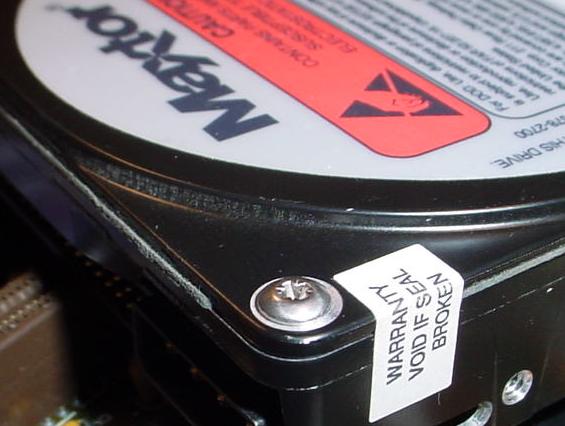
Maxtor 7213A
These were our mainstay for a long, long time, and almost the last of the great Maxtor drives.
These were the days when Windows 3.1 was new and DOS still reigned supreme, when a large space-hogging application came on no less than four floppy discs and everyone had twin drives: the days of the flip-top case and the 386DX-40 with 4MB of RAM in 30-pin SIMMs, of PC Tools and XTree Gold, of the Trident TVGA-9000 512k ISA video card, and inevitably, a Maxtor 7213.
There were other 210MB drives; the Western Digital in particular was a worthy rival; the Seagate, the Quantum, and the Conner were all good performers — but in our view the Maxtor 7213 was the best of all. They were a long-lived model and we sold hundreds upon hundreds of them.
Only a year or two later Maxtor, even then regarded as the grand old survivor of the hard drive industry, would begin to feel the pinch. Stuck in a relentless price war, they would spiral down through a series of ever less-attractive products towards their bankrupcy in mid-decade. But in '92 and '93, Maxtor were right up there with the best of them.
The 7213s lasted well too. Up until about 1997, when Windows 95 became common and a 212MB drive could no longer cut the mustard, the 7213 was still a common sight in older systems. Though we have almost never sold Maxtors in the decade that has passed since then, the 7213s remain amongst our all-time favourite drives, and they gave us very faithful service.
| Performance | 0.56 | Reliability | AA1 |
| Data rate | 22.6 Mbit/sec | Spin rate | 3551 RPM |
| Seek time | 15ms | Buffer | 64k |
| Platter capacity | 106MB | Interface | IDE mode 2 |
| Actuator | voice coil | Form | 3½" 1/3 height> |
| 7213 | 212.8MB | 4 thin-film heads | ***** |
Western Digital Caviar AC2200
The earlier of the two Western Digital 210MB drives. These were very common in the market: we hardly sold any new but have seen many of them over the years since. They were fairly fast but (as with many WD drives from this period) prone to stiction problems — the heads sticking to the surface of the disc. This usually occurs when the machine has been switched off for a long time; the first few shopping days after Christmas and Easter always used to bring in two or three computers that wouldn't spin up because the heads had welded themselves to the discs. There were two short-term cures: in some of the older MFM drives you could rotate the spindle by hand, with sealed units like the AC2200 it was more brutal: switch the drive on while shaking it hard! If the problem recurred, as it usually did, the drive needed replacement.
Until about 1998 all Western Digital drives, by the way, had the exact same master/slave jumper settings. This made them very easy to work with — whether it's 80MB or 3GB, you don't have to scratch around for a manual, just set a single jumper to turn master into slave. The CD-ROM drive makers all adopted the WD jumper setup too. So far, they are still using it.
| Performance | 0.54 | Reliability | AA2 |
| Data rate | 18.7 Mbit/sec | Spin rate | 3652 RPM |
| Seek time | 14ms | Buffer | 64k |
| Platter capacity | 106.3MB | Interface | IDE |
| Actuator | voice coil | Form | 3½" 1/3 height> |
| AC2200 | 212.6MB | 4 thin-film heads | * |
Seagate ST-3243A
Not as common on the market as drives of about this size from Western Digital (212), Conner (210), and Maxtor (213), but a good one. In those days, an extra 2MB was worth having! We sold a few of these, a few more of the Conners, quite a lot of the Western Digitals and absolute bucket loads of the Maxtors.
| Performance | 0.54 | Reliability | AA2 |
| Data rate | 21.1 Mbit/sec | Spin rate | 3811 RPM |
| Seek time | 16ms | Buffer | |
| Platter capacity | 106.8MB | Interface | IDE |
| Actuator | voice coil | Form | 3½" 1/3 height> |
| ST3243A | 213.9MB | 4 thin-film heads | ** |
Conner 210
Like the similar-looking Conner 40MB drives, there were about three different models of Conner 210. The blue-labeled ones were made in a then-new factory in mainland China and developed a bad name, though they came right at the end of the 210's time and you won't see many of them around. The other two were excellent. Specs are for the last and fastest one — the older ones were more modest but more reliable 4-head designs.)
| Performance | 0.64 | Reliability | AA3 |
| Data rate | 32 Mbit/sec | Spin rate | 3600 RPM |
| Seek time | 14ms | Buffer | |
| Platter capacity | 213MB | Interface | IDE |
| Actuator | voice coil | Form | 3½" 1/3 height> |
| CFS-210A | 213.4MB | 2 thin-film heads | ** |
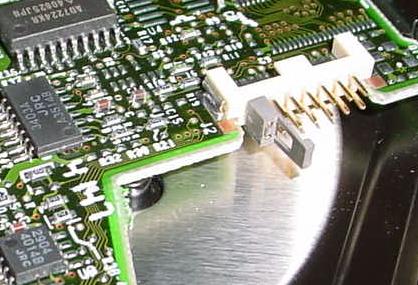
IBM H3256
One of the first IBM drives we stocked as a new product here at Red Hill, this was our primary replacement for the excellent Maxtor 7213, which had been our mainstay throughout 1993. Like the earlier 170MB IBM unit that we had also sold, the H3256 was rather fast and very reliable — a worthy replacement for the Maxtors. Note the very unusual head count — three head drives are not uncommon in these days of massive platter capacities, but were all-but unheard of until about 1998.
Like all IBM drives in those days, the H256 was beautifully finished, with a simple, logical jumper block. (Illustrated at left. The drive pictured is set for Master/stand-alone, the next jumper pair to the right was for slave.)
It is probably hard for the Pentium-coddled generation to appreciate how important this used to be. In 386 days you only had one IDE controller to work with, networks were arcane and vastly time-consuming things to set up, and if you couldn't do a master-slave data transfer you were reduced to a Backpack drive or, worst of all, Laplink. Drive strappings were not documented on the drive itself in those days and many, many times in the workshop we wished that other manufacturers — Conner in particular — would learn from the example set by IBM.
| Performance | 0.61 | Reliability | AA1 |
| Data rate | 26.5 Mbit/sec | Spin rate | 3600 RPM |
| Seek time | 14ms | Buffer | 96k |
| Platter capacity | 171MB | Interface | IDE mode 2 |
| Actuator | voice coil | Form | 3½" 1/3 height> |
| H3256 | 257.2MB | 3 thin-film heads | **** |
Seagate ST-3290A
A typical Seagate from this period: not particularly fast, quite reliable, fuss-free and excellent value for money. They looked almost exactly the same as a Medalist 545, and, for that matter, the same as all the other Seagate IDE drives made in the early to mid 1990s. Notice the model number: like all Seagate drives until about 1995, they used the unformatted capacity to derive it.
| Performance | 0.54 | Reliability | AA2 |
| Data rate | 21.1 Mbit/sec | Spin rate | 3811 RPM |
| Seek time | 16ms | Buffer | 64k |
| Platter capacity | 130MB | Interface | IDE |
| Actuator | Stepper | Form | 3½" 1/3 height> |
| ST-3290A | 260.1MB | 4 thin-film heads | *** |
Western Digital Caviar AC2340
340MB drives never really took off. By the time the price came down enough to be affordable, you could get a 420 for not much more. This was a typical WD drive of the period: fairly quick, fairly reliable, very easy to set up.
| Performance | 0.62 | Reliability | AA2 |
| Data rate | 28 Mbit/sec | Spin rate | 3322 RPM |
| Seek time | 13ms | Buffer | |
| Platter capacity | 170MB | Interface | IDE |
| Actuator | voice coil | Form | 3½" 1/3 height> |
| AC2340 | 341.3MB | 4 thin-film heads | ** |
Maxtor 7345A
The last of the great Maxtor drives before their quality dropped off in the mid-Nineties. This was one of the biggest IDE hard drives in the world when it first came out, and one of the best. A beautifully finished product that oozed quality; visibly different to their tacky-looking drives of a few years later, and (we always thought) indicative of the care that went into making it.
| Performance | 0.62 | Reliability | AA2 |
| Data rate | 30 Mbit/sec | Spin rate | 3551 RPM |
| Seek time | 14ms | Buffer | |
| Platter capacity | 172MB | Interface | IDE |
| Actuator | voice coil | Form | 3½" 1/3 height> |
| 7345A | 345MB | 4 thin-film heads | ** |
Seagate Medalist 425xe (ST-3491A)
Another good Seagate drive, and very comon for quite a while, though a bit sluggish. We sold quite a few.
The Medalist 425xe was overshadowed by the outstanding Medalist 545, which looked almost identical and came out only a little later.
| Performance | 0.63 | Reliability | AA2 |
| Data rate | 32 Mbit/sec | Spin rate | 3811 RPM |
| Seek time | 15ms | Buffer | 120k |
| Platter capacity | 214MB | Interface | IDE mode 3 |
| Actuator | voice coil | Form | 3½" 1/3 height> |
| ST-3491A | 428.1MB | 4 thin-film heads | ** |
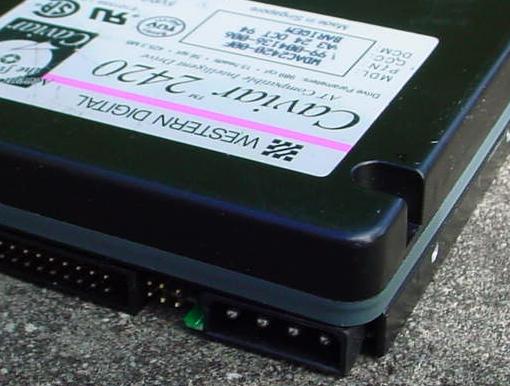
Western Digital AC 1210 and AC2420
Two excellent drives from Western Digital, well and truly worthy of the Caviar name. The smaller unit was very fast in its day and one of the best 210MB drives ever made. These sold in huge numbers and many are still going. The larger two platter drive became popular on the market a little later: it too was very common, and was probably the best 420MB unit of them of all.
Like several other Western Digital drives of early to mid Nineties, these were quite a bit faster in real life than the bare figures suggested. Perhaps the generous on-drive cache helped. At a pinch you can run Windows 95 or 98 quite happily on one of these, and they were still fast enough to be worth owning right up until the 420MB capacity became too limiting.
In fact, the particular drive illustrated is our own much-battered emergency workshop boot drive. It kicks around the Red Hill workshop waiting till we need to access the data on another drive without booting from it, usually for virus scanning or data recovery work. Eight years on, it gets used two or three times a week and still runs just fine.
Western Digital had a purple patch through the early 1990s, and made a series of excellent drives: the Caviar 40, 80, 120, 210, 340, and then this one were all as good or better than most of their competitor's drives. Much of Western Digital's continuing excellent reputation through the second half of the Nineties, when their drives were all too often off the pace and their quality sometimes questionable, dates to this golden period.
| Performance | 0.64 | Reliability | AA1 |
| Data rate | 31 Mbit/sec | Spin rate | 3314 RPM |
| Seek time | 13ms | Buffer | 64k |
| Platter capacity | 213MB | Interface | IDE mode 3 |
| Actuator | voice coil | Form | 3½" 1/3 height |
| AC1210 | 212.6MB | 2 thin-film heads | *** |
| AC2420 | 425.3MB | 4 thin-film heads | ** |
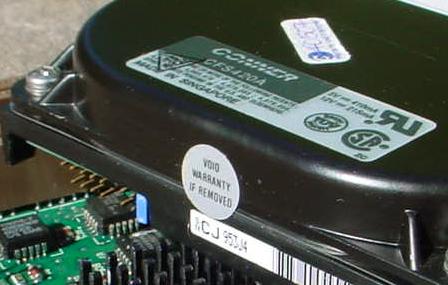
Conner CFS 420A
One of the most common second-hand drives around for a long, long time in the Nineties, and typical Conner: solid, reliable, not very fast. We sold a moderate number of them new, and traded countless others in for years afterwards.
We pulled the one at left out of a working machine just last month — perhaps almost the last one, for (as we revise these pages once again) it is March 2002 already and the useful life of slow 420s must be surely over.
As the years passed, the CFS 420s seemed slower than ever. They proved to be remarkably reliable in the longer-term: they had their share of failures early on but troubles became quite rare after the first year or two. Just the same, better-performed drives of the same era — the WD 420s and Decathlon 850s for example — aged much more gracefully.
Like most Conners, these had an arcane jumper setup and could be ridiculously difficult to master/slave. This was a major issue in those days — it was before dual IDE controllers became common and upgrades almost always involved an external Backpack drive or master/slaving. An IBM or Western Digital to transfer data off brought smiles in the workshop, Seagates and Maxtors and Quantums were OK, opening the soon-to-be upgraded box to find a Conner made for groans and curses. There was no Internet to speak of in those days, and jumper settings were not marked on the drives themselves: you just had to know. With most brands it was fairly easy, but with the Conners nearly every drive was different. Knowing how to set a CFA 170A was no help at all if you were trying to work with a CP 30084 or a CFS 420A. We don't miss them.
| Performance | 0.64 | Reliability | AA1 |
| Data rate | 32 Mbit/sec | Spin rate | 3600 RPM |
| Seek time | 14ms | Buffer | 32k |
| Platter capacity | 210MB | Interface | IDE mode 2 |
| Actuator | voice coil | Form | 3½" 1/3 height> |
| CFS420A | 426.8MB | 4 thin-film heads | *** |


